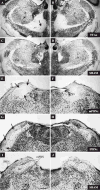Central gustatory lesions and learned taste aversions: unconditioned stimuli
- PMID: 16458940
- PMCID: PMC1447598
- DOI: 10.1016/j.physbeh.2005.12.008
Central gustatory lesions and learned taste aversions: unconditioned stimuli
Abstract
The efficacy of two different unconditioned stimuli (US) in producing conditioned taste aversion (CTA) was tested in rats after bilateral ibotenic acid (IBO) lesions of the gustatory nucleus of thalamus (TTAx) and the medial and lateral parabrachial nuclei (mPBNx, lPBNx). An initial study determined an equivalent dose for the two USs, LiCl and cyclophosphamide (CY), using non-lesioned rats. Subsequently, using a separate set of lesioned animals and their sham controls (SHAM), injections of CY were paired 3 times with one of two taste stimuli (CSs), 0.1 M NaCl for half the rats in each group, 0.2 M sucrose for the other half. After these conditioning trials, the CS was presented twice more without the US, first in a 1-bottle test, then in a 2-bottle choice with water. The acquisition and test trials had 2 intervening water-only days to assure complete rehydration. Two weeks later, the same rats were tested again for acquisition of a CTA using LiCl as the US and the opposite CS as that used during the CY trials. The SHAM and TTAx groups learned to avoid consuming the taste associated with either CY or LiCl treatment. The two PBNx groups failed to learn an aversion regardless of the US.
Figures





Similar articles
-
Thalamocortical relations in taste aversion learning: II. Involvement of the medial ventrobasal thalamic complex in taste aversion learning.Behav Neurosci. 1985 Jun;99(3):477-95. doi: 10.1037//0735-7044.99.3.477. Behav Neurosci. 1985. PMID: 3040033
-
Brainstem lesions and gustatory function: III. The role of the nucleus of the solitary tract and the parabrachial nucleus in retention of a conditioned taste aversion in rats.Behav Neurosci. 1997 Feb;111(1):180-7. Behav Neurosci. 1997. PMID: 9109636
-
Gustatory functions, sodium appetite, and conditioned taste aversion survive excitotoxic lesions of the thalamic taste area.Behav Neurosci. 1997 Jun;111(3):633-45. Behav Neurosci. 1997. PMID: 9189278
-
Neural substrates for conditioned taste aversion in the rat.Behav Brain Res. 1994 Dec 15;65(2):123-37. doi: 10.1016/0166-4328(94)90097-3. Behav Brain Res. 1994. PMID: 7718144 Review.
-
Toxin-induced conditioned changes in taste reactivity and the role of the chemosensitive area postrema.Neurosci Biobehav Rev. 1995 Spring;19(1):99-108. doi: 10.1016/0149-7634(94)00024-u. Neurosci Biobehav Rev. 1995. PMID: 7770201 Review.
Cited by
-
Gustatory insular cortex lesions disrupt drug-induced, but not lithium chloride-induced, suppression of conditioned stimulus intake.Behav Neurosci. 2008 Oct;122(5):1038-50. doi: 10.1037/a0012748. Behav Neurosci. 2008. PMID: 18823161 Free PMC article.
-
Integrative responses of neurons in parabrachial nuclei to a nauseogenic gastrointestinal stimulus and vestibular stimulation in vertical planes.Am J Physiol Regul Integr Comp Physiol. 2012 Apr 15;302(8):R965-75. doi: 10.1152/ajpregu.00680.2011. Epub 2012 Jan 25. Am J Physiol Regul Integr Comp Physiol. 2012. PMID: 22277934 Free PMC article.
-
Taste neophobia and c-Fos expression in the rat brain.Brain Res. 2012 Apr 11;1448:82-8. doi: 10.1016/j.brainres.2012.02.013. Epub 2012 Feb 12. Brain Res. 2012. PMID: 22405689 Free PMC article.
-
Inhibiting gustatory thalamus or medial amygdala has opposing effects on taste neophobia.Neurobiol Learn Mem. 2018 Dec;156:24-32. doi: 10.1016/j.nlm.2018.10.004. Epub 2018 Oct 15. Neurobiol Learn Mem. 2018. PMID: 30336209 Free PMC article.
-
Role of the gustatory thalamus in taste learning.Behav Brain Res. 2013 Aug 1;250:9-17. doi: 10.1016/j.bbr.2013.04.039. Epub 2013 Apr 30. Behav Brain Res. 2013. PMID: 23644184 Free PMC article.
References
-
- Spector AC, Norgren R, Grill HJ. Parabrachial gustatory lesions impair taste aversion learning in rats. Behav Neurosci. 1992;106:147–61. - PubMed
-
- Yamamoto T, Fujimoto Y, Shimura T, Sakai N. Conditioned taste aversion in rats with excitotoxic brain lesions. Neurosci Res. 1995;22:31–49. - PubMed
-
- Reilly S, Trifunovic R. Lateral parabrachial nucleus lesions in the rat: long- and short-duration gustatory preference tests. Brain Res Bull. 2000;51:177–86. - PubMed
-
- Reilly S, Trifunovic R. Lateral parabrachial nucleus lesions in the rat: aversive and appetitive gustatory conditioning. Brain Res Bull. 2000;52:269–78. - PubMed
-
- Reilly S, Trifunovic R. Lateral parabrachial nucleus lesions in the rat: neophobia and conditioned taste aversion. Brain Res Bull. 2001;55:359–66. - PubMed
Publication types
MeSH terms
Substances
Grants and funding
LinkOut - more resources
Full Text Sources

